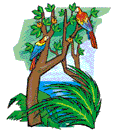Cycles of Life: Water, Trees, Carbon, Nitrogen
A lesson and worksheet on how materials are recycled in nature.
Objectives:
• Students will be able to describe what it means to recycle.
• Students will be able to describe what happens throughout the water cycle.
• Students will be able to describe how decomposers break down dead plants and animals to provide nutrients for living plants and animals.
• Students will be able to state why carbon and nitrogen are vital to life.
Suggested Grades:
3rd Grade - 4th Grade - 5th Grade
Print the reading comprehension worksheet passage and questions (see below).
Students should read the passage silently, then answer the questions. Teachers may also use the text as part of a classroom lesson plan.
Lesson Excerpt:
In nature, materials are recycled all the time. When a substance is recycled, it is turned into a new material that can be used by another system in the environment. One important example of recycling in nature is the water cycle. Water changes form all the time. After it rains, for example, you may see puddles on the ground or notice that grass or soil is wet. Where does the water go?
Nature recycles water through a process called evaporation. Heat from the sun causes the water to change form from liquid to gas. It goes into the air as water vapor. When water vapor cools, it becomes liquid again through a process known as condensation. When water droplets gather, they form clouds. As soon as the cloud gets too big and too heavy to stay in the air, the droplets fall to the ground. This is called precipitation. You may know it as rain, sleet, snow or hail!
Continued...

Lesson Printables:
Print this printable worksheet for this lesson:


